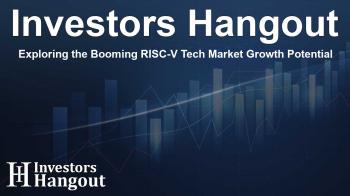Exploring the Booming RISC-V Tech Market Growth Potential

RISC-V Tech Market Size & Growth Insights
The RISC-V tech market is gaining remarkable traction as it evolves to meet various technological demands. Initially valued at USD 1.44 billion in 2024, projections suggest it will surge past USD 11.50 billion by 2032, representing an impressive growth rate of 29.66% from now until then.
Key Drivers Behind RISC-V Market Expansion
Innovations and global shifts toward open-source chip technologies are the main drivers propelling RISC-V market expansion. Initially considered limited to sectors like IoT, blockchain, and semiconductor industries, RISC-V is breaking new ground. Notable achievements such as DeFacto's SoC automation and advancements in 2D materials, illustrated by developments like China's one-nanometer Wuji chip, underline the performance potential of this architecture. In the RISC-V landscape, the USA is leading with a market size of USD 0.99 billion, expected to increase to USD 7.33 billion by 2032 due to persistent investments in open-source architectures.
Geopolitical Influences on RISC-V Adoption
Countries like India are now eyeing RISC-V as a strategic asset to diminish reliance on established technologies like ARM and x86. Initiatives such as the Jiachen Project in China highlight a significant worldwide demand for an open, license-free instruction set and processor, showcasing RISC-V's relevance in global markets.
Regional Insights into The RISC-V Market
Analysis of regional dynamics reveals that North America will continue its dominance in the RISC-V market. With expectations to hold 44% of the revenue share in 2024, driven by advanced technological frameworks, the United States stands at the forefront. Conversely, the Asia-Pacific region is anticipated to see the most rapid growth at a CAGR of 31.68%, fueled by intense industrialization and digital transformation efforts in countries like China and India. These regions are adopting RISC-V to mitigate the impact of US export controls.
Emerging Trends Across Markets
In Europe, there's a growing interest in RISC-V, particularly in nations like Germany and France, which are focused on technological independence. Meanwhile, Latin America is using RISC-V to drive innovation and lessen foreign dependency. In regions like the Middle East and Africa, investments in open-source architectures are paving the way for improved self-reliance and driving smart infrastructure initiatives.
RISC-V Market Trends by Application
As the tech landscape shifts, applications of RISC-V technology are expanding. By 2024, IoT devices are projected to dominate the market, expected to hold a revenue share of approximately 35%. This rise can be attributed to the proliferation of smart, connected devices in sectors such as healthcare, manufacturing, and transportation.
Increasing Demand in Consumer Electronics
The consumer electronics segment will likely lead the RISC-V market in 2024 with around 24% of total revenue share. With greater demand for smart technologies, including TVs and home automation devices, continuous advancements in connectivity will bolster this market further. The automotive sector is also poised for substantial growth, driven by developments in electric vehicles and smart mobility solutions, projecting an impressive CAGR of 36.77%.
Competitive Landscape and Key Players
As the RISC-V ecosystem expands, various key players are emerging. Companies like Ventana Micro Systems, Cypress Semiconductor, SiFive, Google, Samsung, Loongson, Intel, Xilinx, Huawei, and Qualcomm are at the forefront, contributing significantly to this rapidly evolving market.
Recent Developments Impacting RISC-V Growth
In recent months, there have been considerable advancements in technology that will impact the RISC-V market. For instance, Samsung recently celebrated a decade of SDC24, showcasing AI advancements that facilitate seamless multi-device interactions. Additionally, there have been collaborative moves among Intel and AMD to harmonize the x86 instruction set architecture, highlighting the industry's focus on optimized performance.
Frequently Asked Questions
What is the projected growth rate of the RISC-V market?
The RISC-V market is projected to grow at a CAGR of 29.66% from 2025 to 2032.
Which regions are expected to lead in RISC-V adoption?
North America will lead the market, with significant growth anticipated in Asia-Pacific as well.
What applications will drive RISC-V technology in the coming years?
IoT devices, consumer electronics, and automotive technology will significantly contribute to RISC-V's growth.
Who are the key players in the RISC-V market?
Key players include Ventana Micro Systems, Intel, Google, and Qualcom among others.
How does RISC-V contribute to technological independence?
RISC-V offers an open-source architecture that reduces dependency on established technologies like ARM and x86.
About The Author
Contact Thomas Cooper privately here. Or send an email with ATTN: Thomas Cooper as the subject to contact@investorshangout.com.
About Investors Hangout
Investors Hangout is a leading online stock forum for financial discussion and learning, offering a wide range of free tools and resources. It draws in traders of all levels, who exchange market knowledge, investigate trading tactics, and keep an eye on industry developments in real time. Featuring financial articles, stock message boards, quotes, charts, company profiles, and live news updates. Through cooperative learning and a wealth of informational resources, it helps users from novices creating their first portfolios to experts honing their techniques. Join Investors Hangout today: https://investorshangout.com/
The content of this article is based on factual, publicly available information and does not represent legal, financial, or investment advice. Investors Hangout does not offer financial advice, and the author is not a licensed financial advisor. Consult a qualified advisor before making any financial or investment decisions based on this article. This article should not be considered advice to purchase, sell, or hold any securities or other investments. If any of the material provided here is inaccurate, please contact us for corrections.

